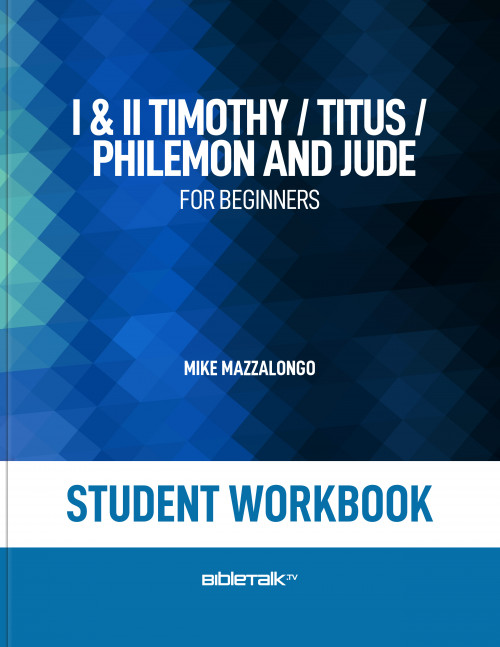The Reason for Paul's Letter to Timothy
In chapter 1:3-4, Paul tells Timothy that the set purpose of his letter was to encourage the young evangelist to maintain sound doctrine and instruct others who were doing otherwise. Part of the work of a minister is to teach the Bible accurately while another part is to correct those who may be in error and consequently teaching what is incorrect. With this in mind, Paul writes to Timothy and includes the following information and teaching:
- Chapter 1:1-2 - Paul endorses Timothy and thus provides him with the authority he needs to carry out his ministry as an evangelist.
- Chapter 1:3-11 - The presence of false teachers and doctrines as well as the need for correction are noted.
- Chapter 1:12-17 - Paul's witness of his own conversion and appointment as an Apostle of Jesus.
- Chapter 2:1-7 - The need and subject of prayer is developed.
- Chapter 2:8 - Who and how prayer is to be offered.
- Chapter 2:9-15 - The role and position of men and women in the church in general.
- Chapter 3:1-7 - The duties and qualifications of elders are outlined.
- Chapter 3:8-13 - The duties and qualifications of deacons and the wives of elders and deacons are also provided.
These are the verses and subjects that we have covered so far in our study.
In the last section of chapter 3:14-16, Paul himself will summarize the instructions that he has thus far given to Timothy.
Mystery of Godliness — I Timothy 3:14-16
I am writing these things to you, hoping to come to you before long;
- I Timothy 3:14
We have a shift here as Paul describes some of his present circumstances and plans to see Timothy in person in order to provide more in-depth teaching.
but in case I am delayed, I write so that you will know how one ought to conduct himself
- I Timothy 3:15a
In case he is delayed, however, he includes the written instructions in this letter so Timothy can handle the situation himself. Paul repeats the idea that what he writes has a specific goal: to instruct the members of the church concerning their conduct. This is the main reason for his instructions on prayer, the role of men and women, and the selection process for elders and deacons. Paul says that as Christians we have a specific way to act, to organize ourselves and relate to each other as members of the church.
in the household of God, which is the church of the living God, the pillar and support of the truth.
- I Timothy 3:15b
Note how he refers to the church:
- Household of God – God is the Father, we are His children. We are related because we have the same Father and we dwell in His household which is the church.
- Church of the Living God – The Christian church belongs to and obeys the God who is real and alive. This as opposed to the churches, philosophies, religions and ideologies that follow gods that are dead (pagans), ideas that are of men, religions that honor false gods, human traditions and man-made deities.
- Pillar and Support of the Truth – The idea is that the main role of God's household, the living God's church, is to be the depository and promoter of God's truth. The church preserves the truth, defends the truth and proclaims the truth. The "truth" that he talks about here is explained in greater detail in the next verse where he will refer to "truth" as "the mystery of godliness."
By common confession,
- I Timothy 3:16a
This is a way of saying "as the church is in the habit of saying or singing," or "as I often say." The idea is that Paul may be quoting a popular hymn or psalm that was said or sung by the early church which summarized the great truths contained in the gospel message.
great is the mystery of godliness:
- I Timothy 3:16b
At first he says "truth," now he refers to this "truth" that the church is to preserve and proclaim as "the mystery of godliness." Two ways of saying the same thing. The "gospel" is the truth, is the mystery!
- Truth - in that the gospel explains who the true God is, what man's true condition is, how God has saved man from condemnation, what happens after death and who God sent as the true Savior.
- Mystery - This truth about God, man's condition, salvation and the future was not known in its entirety until it was revealed by Jesus Christ.
He who was revealed in the flesh, Was vindicated in the Spirit, Seen by angels, Proclaimed among the nations, Believed on in the world, Taken up in glory.
- I Timothy 3:16c
Here Paul either recites the hymn or summarizes its content. Either way, he lists for Timothy the main points in the hymn, the major ideas and the teaching of the gospel itself. The "truth" or "mystery of godliness" he says, can be summarized in the following way:
1. Revealed in the Flesh
In the beginning was the Word, and the Word was with God, and the Word was God.
- John 1:1
And the Word became flesh, and dwelt among us, and we saw His glory, glory as of the only begotten from the Father, full of grace and truth.
- John 1:14
The Incarnation: the belief that God became man in the form of Jesus of Nazareth. This is the first and foremost teaching of the gospel and the statement all believers confess as they are baptized into Christ. Every major attack against Christianity from the first century until today, usually begins by denying this or trying to change this to something less or something different. The church is the defender and promoter of this truth.
2. Vindicated in the Spirit
who was declared the Son of God with power by the resurrection from the dead, according to the Spirit of holiness, Jesus Christ our Lord,
- Romans 1:4
The resurrection. The vindication (confirmation) that Jesus was the Son of God and was speaking truth was demonstrated by His resurrection. In Romans 8:11 Paul says that Jesus' resurrection was powered by the Holy Spirit. To all who doubt, disbelieve or deny that Jesus is God, the Holy Spirit responds with the resurrection of Jesus to prove (vindicate) that every claim He made about Himself or His mission was true.
3. Beheld by Angels
Not only was Jesus' resurrection witnessed by hundreds of people here on earth, it was also witnessed by those in the spiritual realm as well.
11But Mary was standing outside the tomb weeping; and so, as she wept, she stooped and looked into the tomb; 12and she saw two angels in white sitting, one at the head and one at the feet, where the body of Jesus had been lying.
- John 20:11-12
This means that even Satan (created as an angelic being) is aware of Jesus' resurrection, as well as the angels in heaven. Both the physical and the spirit world have witnessed the resurrection of Christ.
4. Proclaimed Among the Nations
Beginning at Jerusalem and outward to all nations, the truth about Jesus has been and continues to be preached to all men (I Timothy 2:4-6). Jesus gave this instruction to His Apostles after His resurrection and, many years later, Paul says that this instruction was carried out fully.
18And Jesus came up and spoke to them, saying, "All authority has been given to Me in heaven and on earth. 19Go therefore and make disciples of all the nations, baptizing them in the name of the Father and the Son and the Holy Spirit, 20teaching them to observe all that I commanded you; and lo, I am with you always, even to the end of the age."
- Matthew 28:18-20
5. Believed on in the World
Beginning at Pentecost where three thousand were baptized, we see that the truth has continually gained believers.
40And with many other words he solemnly testified and kept on exhorting them, saying, "Be saved from this perverse generation!" 41So then, those who had received his word were baptized; and that day there were added about three thousand souls.
- Acts 2:40-41
As long as the truth is preserved and proclaimed, it will bear fruit.
6. Taken up in Glory
The ascension of Jesus into heaven.
And after He had said these things, He was lifted up while they were looking on, and a cloud received Him out of their sight.
- Acts 1:9
After completing His preaching, death on the cross, resurrection and final instructions concerning the proclamation of the gospel, Jesus is visibly taken into heaven. An actual preview of what our own transformation will be like after we are resurrected from the dead.
And so Paul finishes summarizing the "truth" or the "mystery of godliness" that the church is to uphold and promote by listing the doctrinal "highlights" of the gospel contained in a hymn or poem commonly used in the church of that era.
Summary
In the first three chapters Paul outlines four basic teachings for Timothy to receive and pass on:
- There is a specific order and organization that needs to be followed in the church.
- Leaders in God's church need to be qualified before being appointed to leadership roles.
- Members of the church need to conduct themselves according to God's will and not be conformed to the image of the world.
- The role of the church and its main duty is to preserve the teachings of Christ and proclaim the gospel to the world.
Note that a majority of the problems in the "Christian" world are a direct result of violating these principles. For example:
- Many have abandoned the organizational model of the church outlined in the Bible and have substituted their own model. This has led to division.
- Religious leaders are chosen for education, length of service, popularity or reasons other than the list of qualifications given by Paul. We even have homosexuals serving as bishops in some groups! These types of departures have multiplied religious error.
- Church members refuse to let go their worldly and sinful attitudes when they are converted, or return to them instead of maturing spiritually. This contributes to the general weakening of the church.
- Churches focus on social programs, youth activities and building projects but neglect to prioritize the serious teaching of God's word and the proclamation of the gospel to the lost. They have worldly success as organizations but become spiritually unfruitful.
Paul was aware that not all of his instructions would be followed so in the next chapter he will provide a series of warnings as well as godly advice to Timothy on how to deal with adversity as a minister.
Discussion Questions
- Summarize Paul's key points in I Timothy 1-3:13.
- What is the "Mystery of Godliness" and why would he refer to it in this way? (I Timothy 3:14-16)
- Explain how Paul refers to the church in I Timothy 3:15.
- Discuss the following questions from I Timothy 3:16:
- What is "revealed in the flesh" and what is the importance of God being revealed in the flesh?
- What is meant by "vindicated in the Spirit"?
- What is meant by "beheld by angels"?
- What is "proclaimed among the nations" and "believed on in the world" and what was the result?
- What are the four basic teachings of Paul for Timothy to pass on and what is our role today?
- How can we use this information to remain faithful and help others grow spiritually?




